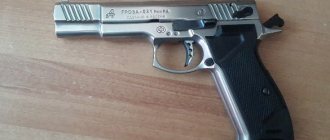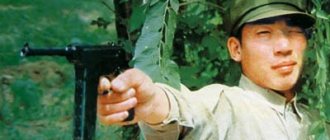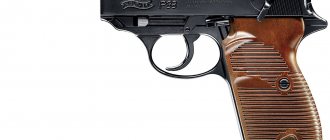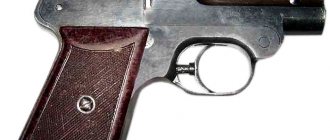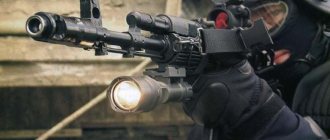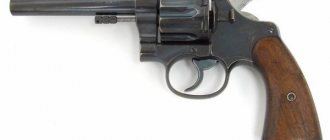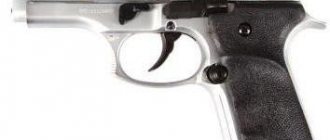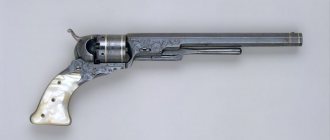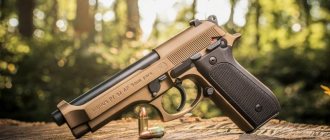Pistols (USA)
, Southport, Connecticut, began manufacturing the .22 caliber blowback automatic pistol developed in 1949 by William Ruger.
Thanks to its simplicity, reliability, combat accuracy and low price, this model immediately gained wide popularity. Subsequently, Ruger came to the conclusion that there was a whole army of fans of the Colt Army revolver model 1873, extremely disappointed that the manufacturing company had ceased production of this legendary weapon. In the early 1950s, Sturm, Ruger and Company began producing the Colt 1873 revolver with such success that it even reconsidered its decision to no longer produce this single-action military model, not to mention the numerous other gunsmiths who, according to Following the example of Ruger, they rushed to develop the gold mine, releasing their own imitations of the Colt system in huge quantities.
Meanwhile, the Sturm, Ruger and Company models are not mechanical copies of an outdated model. The revolvers of this company are perfectly designed and bear a clear imprint of the original design ideas of the developers. This model has been modernized several times, and each time it has been embodied in the latest advances in technology and safety.
Most recently, the company introduced a new version of these double-action trigger revolvers designed for police and home security, as well as a modern cap revolver, an automatic pistol with a clutch action, and several models of rifles and carbines.
LCP to order
In 2015, Ruger introduced the custom LCP model. It is easily distinguished by its red hard anodized aluminum trigger, which features a shorter, improved pull geometry. LCP Custom also features improved higher profile sights. The replacement front sight attaches in the same manner as Glock front sights and is compatible with the Glock sight removal tool. The rear sight is also replaceable and is attached with a trapezoidal slot. The LCP front sight is custom phosphorescent "glow in the dark," while the rear sight is plain black. This model was discontinued with the introduction of LCP II.
Pistol "Standard"
This .22 caliber blowback pistol, introduced in 1949, was the fertile soil from which the rest of the Ruger pistols would subsequently grow. It had an open, fixed barrel and a tubular bolt box, inside which a cylindrical bolt moved.
It could be pulled back by the grooved protrusions that came out at the rear of the bolt box. The cartridge ejection window was located on the right side, and the handle held a magazine for nine rounds. The hidden trigger was designed to ensure that the firing mechanism was fired as quickly as possible.
The sight, mounted on a dovetail on the cover of the bolt box, moved in a horizontal plane. The standard barrel length was 4.75 or 6 inches. The popularity of the pistol was undoubtedly facilitated by the successful efforts of William Ruger, who repeated the general shape and balance of the Parabellum (Luger) pistol.
RUGER.
Section of a standard pistol chambered for the .22 LR cartridge.
Pistol Mk 1 (Mark 1)
The rapid success of the Standard pistol created a demand for weapons for target shooting. Sturm, Ruger and Company responded with the Mk 1, which appeared in 1951. The frame and bolt box were kept the same, but the barrel became heavier, and the sighting device was now adjustable.
When the new barrel was not to the taste of some potential buyers, the company quickly improved its product, equipping the Tagit modification of the Mk 1 pistol with a 6.88-inch tapered barrel, and the bull barrel modification with a reinforced cylindrical barrel.
Generic Application Error Test JSP (Item)GenericApplicationError
- info
- tools
- Reply to message
Sergey-4030
excluding the third
Sergey-4030
>> The descent on the Ruger is very interesting.
U235
> Is it not double-action, but only self-cocking?
What's the difference? He's a DA, but who cares? The point of the post was that the descent is sooooo long and tight.
U235
> Take Walter PPK 9x17, which looks almost a complete analogue of Ruger.
Google the mass and size of both.
- 3
- info
- tools
- Reply to message
old-timer
Sergey-4030
> Google the mass and size of both.
The PPK is not much larger, just enough to fit properly in your hand.
True, it is really 2 times heavier. But this is only 635 grams for PPK/S and 590 grams for PPK. God knows how much harder it is, but they can simply hit you in the skull if you don’t want to shoot, without fear that the gun will fall apart.
By the way, I don’t understand why the Americans ruined an elegant European pickpocket with a larger and more massive frame?
- 2
- info
- tools
- Reply to message
Pistol Mk 2 (Mark 2)
This target pistol, which appeared in 1982 and was intended to replace the Mk 1 series model in production, also had two main modifications: the Mk 2 “tagit” and the Mk 2 “bull barrel”, but differed from its predecessor in an improved magazine latch, an improved magazine, a new a bolt delay design, a modified hammer and a redesigned safety lever.
Another modification, the “Government Tagit,” differed from the Mk 2 “bull barrel” in its even heavier barrel, 6.9 inches long.
Revolver "Single Six"
The first Ruger revolver, introduced in 1953, was based on the Colt M-1873, a six-shot single-action model with a solid frame, loading door and ejector cleaning rod.
Trying as much as possible to preserve the appearance of the original, Ruger replaced the leaf springs with cylindrical coil springs, which significantly increased the operational reliability of the weapon, and installed an inertial striker in the frame shield. Initially, the Single Six was chambered for the .22 LR cartridge, but quite soon a modification appeared chambered for the .22 Winchester Magnum rimfire cartridge.
The barrel length for different options was 4.63; 5.5; 6.5 and 9.5 inches. The Arms Act 1968 imposed the most stringent safety requirements on all models of pistols and revolvers. As a result, no single-action revolver based on the old Colt trigger could pass the rigorous official tests, and so most manufacturers were forced to either modify or abandon their models.
Thanks to the use of an inertial striker, the Single Six revolver needed only minor modifications, after which it would begin to meet all state standards. The trigger mechanism was modified in such a way that the hammer, which accidentally fell off the cocking mechanism, hit not the firing pin, but the protrusion of the frame. The safety plate provided in this version of the firing mechanism transmitted the hammer blow to the striker only if the trigger was pulled.
When the trigger was released, this plate lowered, so that even the strongest blow to the trigger could not make the weapon fire. Around the same time, the traditional sear cutouts, which allowed the hammer to be placed at half-cock and quarter-cock, disappeared, so that now it could occupy only two positions - lowered and cocked.
In the original, still “Kolt” version, the loading door was connected precisely to the half-cocked hammer, so additional work was required on the trigger mechanism so that the drum stop and safety plate would be recessed when the door was open, allowing the drum to rotate freely. All these innovations appeared in 1973 on the so-called “new” model or “super single six” model.
RUGER.
Pistol Mk 2 "stainless" .22 caliber.
Based on materials from STURM, RUGER & COMPANY.
review
Weighing just 9.4 ounces (266.5 g), it is Ruger's first entry into the field of tiny, ultralight defensive pistols. LCP stands for "Light Compact Pistol" and was developed in response to customer requests for a compact weapon for police backup use, and as a defensive pistol for civilian concealed carry needs.
The pistol has a glass-filled nylon frame, dual finger grips, and a through-hardened blued steel slide. It is similar in appearance to the Kel-Tec P-3AT which weighs 8.3 ounces. and uses a similar tension spring for a lightweight hammer, identical to the locked breech mechanism, and a similar material removal method. The main differences are the Glock style extractor and the inclusion of an external slide stop. You can tell if there is a round chamber by looking at the "look hole" next to the hood.
In 2013, a seven round extended magazine was released on LCP.
Revolver "Bearcat"
A not too expensive revolver with that name, chambered in .22 LR, very similar to the Single Six model, but with a fixed sight, was produced with a 4-inch barrel.
The frame of this model was made of steel or a lightweight alloy, the safety bracket was brass, and the surface of the drum was covered with elaborate engraving. In 1973, the Bearcat was modernized to new standards and was almost equal to the Super Single Six, but in 1974 its production suddenly ceased.
Revolver "Hawkeye"
The development of small-bore revolver cartridges with high muzzle velocities in the early 1960s inspired intensive work by many American experimental designers.
Adding fuel to the fire was the introduction in 1961 of the Smith & Wesson Model 53 revolver, chambered for the .22 Remington Jet cartridge, and the subsequent development of the bottle-cased .256 Winchester Magnum cartridge, which was believed to be capable of give the bullet a muzzle velocity of 2400 fps. The use of such powerful cartridges immediately created certain problems; in particular, the recoil was so strong that spent cartridges were often pushed out of the chambers and, catching the bottom of the frame, prevented the normal rotation of the drum. Ruger tried to solve this problem by creating a single-shot Hawkie pistol based on the Blackhawk revolver (see below). The part of the pistol that looked like a drum was actually an original bolt with a chamber for a single cartridge.
In order to align it with the barrel, it was enough to simply turn the “drum”, after which the cartridge was sent into the chamber of the barrel. The reverse rotation of the cylindrical “drum” locked the cartridge in the chamber, providing the bottom of the cartridge case with a reliable stop.
A single hole was drilled into the steel surface that covered the chamber for an inertial firing pin placed inside. When the bolt was opened, the ejector was activated, removing the spent cartridge case from the chamber. For the difficult technical problem described above, this was a very elegant engineering solution, but the beautifully made Hawkie never gained any particular popularity, and its production ceased in 1967.
RUGER.
Single Six revolver chambered for .32 Magnum. Based on materials from STURM, RUGER & COMPANY.
Acquaintance
According to many experts, all models of Ruger revolvers are characterized by high quality workmanship and reliability. The main feature of these shooting units is the presence of a special push-button latch for the drum. Judging by numerous reviews from owners, it is no less convenient than the sliding one, which the Smith-Wesson company uses for its products. The drum has fixation grooves. In the six-shot version of the revolver, American designers moved the recesses away from the chamber, thanks to which the walls of the drum retained their previous thickness and strength. In the production of Ruger revolvers, stainless steel is used, which undergoes a matte finish. They also use durable rubber for the cheeks of the handles, which are attached to the weapon with screws.

